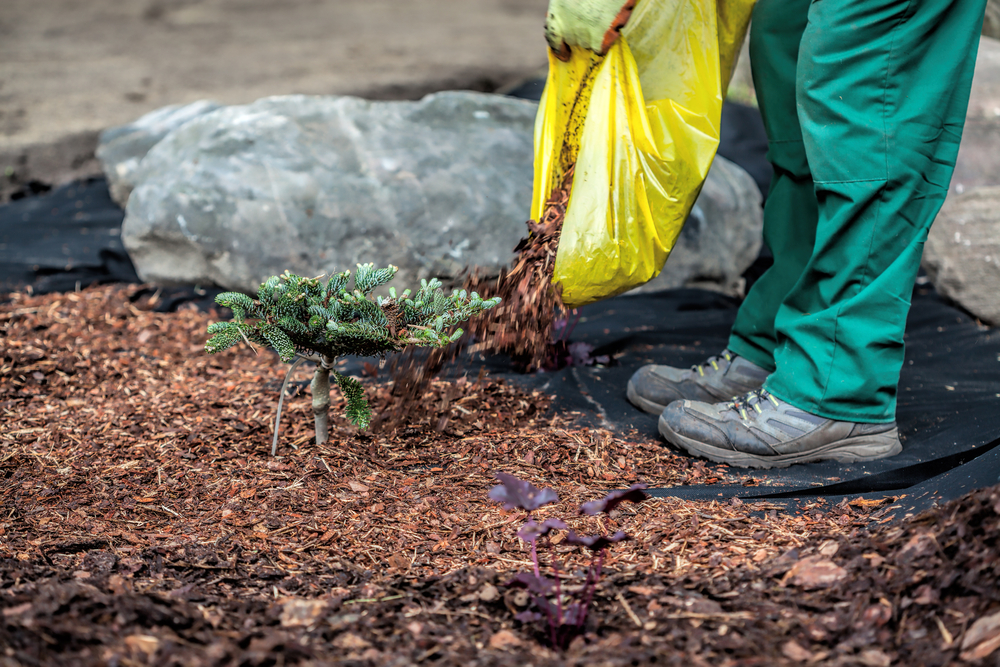If you’re one of the 49% of Americans who have gardened within the past year, it is easy to understand how reaping what you sow can save you money in the long term. For every $70 invested in garden landscaping, a homeowner can expect to receive approximately $530 in produce per given season.
Looking for more ways to cultivate your garden landscaping on a budget? Here are garden landscaping ideas that will help save you money this year:
Mulching
Mulching is a practical and visually appealing way to enhance your garden’s health and beauty. Not only does mulch add a neat and finished look to your landscape, but it also provides numerous benefits for soil health. It helps retain moisture, regulates soil temperature, and suppresses weed growth. Mulch is especially valuable during the hotter months, as it keeps the soil cool and reduces evaporation, helping plants withstand the summer heat. For best results, apply mulch in the late spring or early summer to prepare your garden for the growing season. Many landscape supply companies offer colored mulch options, so you can add a pop of color to complement your garden design.
Trimming and Weeding
Regular trimming and weeding are essential to maintaining a polished, well-kept garden. Consistent maintenance prevents weeds from taking over, ensures your lawn looks tidy, and promotes healthier plant growth. Trimming overgrown trees and shrubs encourages them to grow in a balanced way, reducing the risk of broken branches and disease. Most arborists recommend trimming during the dormant season, which is typically late fall or winter, as it minimizes stress on the plants and encourages more vigorous growth in the spring.
The Small Touches Count
Adding small decorative touches can make a big difference in the overall look of your landscape. Elements like decorative stones, gravel paths, or a sand garden can create eye-catching focal points. You can also experiment with different textures and colors by using various types of mulch, stones, or even pebbles around flower beds or along pathways. Small additions like these can tie your garden together, giving it a cohesive and well-thought-out appearance without breaking the bank.
Think Local
When selecting plants for your garden, consider choosing native species. Local plants are well-adapted to the climate and soil conditions in your area, which means they generally require less water, fertilizer, and maintenance. They also support the local ecosystem by providing food and shelter for native wildlife. By choosing native plants, you’re not only saving time and money, but you’re also promoting biodiversity and contributing to a healthier environment. Check with local nurseries or gardening centers to find out which plants are native to your region or read guides on native plants written by local experts.
Call the Experts
While DIY projects can be rewarding, there are times when it’s worth consulting with a professional. Landscaping experts can provide insights into design options you might not have considered and can recommend plants and materials that work best for your specific space. Professional landscapers also have the expertise and equipment to handle larger projects efficiently and safely. By enlisting their help, you can ensure your garden not only meets but exceeds your expectations. They can also offer ongoing maintenance plans to keep your garden looking its best year-round.
Plan for Year-Round Interest
To keep your garden attractive all year, include plants that provide interest in every season. For example, consider evergreens for winter, flowering bulbs for spring, perennials for summer, and shrubs with vibrant foliage for fall. Adding elements like ornamental grasses, which sway in the breeze, or shrubs with colorful berries, can bring texture and color to your garden even during the colder months. A year-round garden ensures you always have something beautiful to look at, regardless of the season.
Create Focal Points
Focal points draw the eye and add structure to your garden. You can create focal points with garden features like a birdbath, a unique sculpture, or a beautiful tree. A well-placed garden bench or arbor can also serve as a focal point, encouraging people to spend time in that area. When choosing focal points, consider scale and placement to ensure they complement the surrounding plants and garden layout. A thoughtfully designed focal point can add personality and make your garden feel more intentional.
Embrace Vertical Space
If you have limited garden space or want to add dimension to your landscape, think vertically. Use trellises, arbors, or vertical planters to make the most of your garden’s vertical space. Climbing plants like ivy, clematis, or wisteria can add greenery and blooms without taking up too much ground space. Vertical gardening is also an excellent way to create privacy, as it can screen off areas or block unsightly views. Incorporating vertical elements can make even a small garden feel lush and full.
Install Pathways for Accessibility
Pathways not only add charm to your garden but also provide practical benefits. They guide visitors through your garden, allowing them to explore without damaging delicate plants. Paths can be made from various materials like gravel, stepping stones, or pavers, each adding a unique look to your landscape. When designing pathways, consider the overall flow and make sure they are wide enough for easy navigation. Adding pathways also makes maintenance easier, as you can access plants and beds without trampling over soil and compacting it.
Incorporate Water Features
Water features like fountains, ponds, or birdbaths can enhance the tranquil atmosphere of your garden. The sound of flowing water can create a soothing ambiance, attracting birds and other wildlife, which can bring your garden to life. Water features don’t have to be large or elaborate; even a small bubbling fountain can make a big impact. Choose a feature that fits your garden size and style, and ensure it’s located near a power source if it requires electricity. Water features can be a wonderful focal point and add a sense of peace and relaxation to your outdoor space.
Read More

